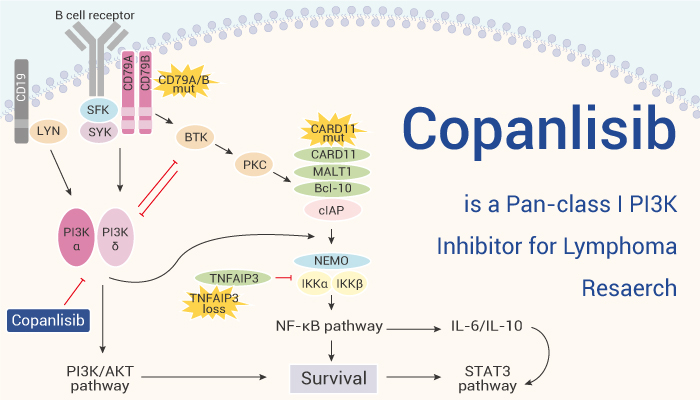PI3K has four isoforms, PI3Kα, PI3Kβ, PI3Kδ and PI3Kγ. PI3K plays an important role in cell proliferation, survival, differentiation, migration and angiogenesis. Moreover, Several processes can lead to the activation of PI3K. For example, somatic mutation, amplification of the PIK3CA gene, and loss of function of PTEN. Besides, PI3K activation is tightly associated with the development of cancer. Therefore, PI3K family is an important target for cancer research. Copanlisib (BAY 80-6946) is a potent, selective and ATP-competitive pan-class I PI3K inhibitor. Importantly, FDA has approved Copanlisib (Aliqopa™) for relapsed/refractory follicular lymphoma treatment.
Copanlisib, a pan-class I PI3K inhibitor, can be used for lymphoma research.
In vitro, Copanlisib inhibits all four PI3K isoforms with IC50s of 0.5 nM, 0.7 nM, 3.7 nM and 6.4 nM for PI3Kα, PI3Kδ, PI3Kβ and PI3Kγ, respectively. In addition, Copanlisib shows more than 2,000-fold selectivity against other lipid and protein kinases, except for mTOR (IC50: 40 nM). Besides, Copanlisib potently inhibits cell proliferation in a panel of human tumor cell lines (mean IC50: 19 nM), and induces cell apoptosis. In ELT3 cells, Copanlisib (0.5-500 nM; 2 hours) shows complete inhibition of PI3K-mediated AKT phosphorylation in ELT3 cells.
In vivo, in a rat KPL4 breast tumor xenograft model, Copanlisib (0.5-6 mg/kg; i.v.; every second day, five doses) shows robust antitumor activity, with TGI rates of 77%-100%. Besides, in a rat pharmacokinetic assay, Copanlisib (1 mg/kg, i.v.) shows a large volume of distribution (Vss: 32 L/kg), high plasma clearance (3.95 L/kg·h) and long T1/2 (6.0 hours).
In conclusion, Copanlisib is a pan-class I PI3K inhibitor with antitumor activity, and for can be used for cancers, such as breast cancer and lymphoma.
References:
[1] Ningshu Liu, et al. Mol Cancer Ther. 2013 Nov;12(11):2319-30.
[2] Markham A. Drugs. 2017 Dec;77(18):2057-2062.
